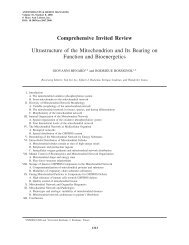MiPsummer Programme pdf - Mitochondrial Physiology Society
MiPsummer Programme pdf - Mitochondrial Physiology Society
MiPsummer Programme pdf - Mitochondrial Physiology Society
You also want an ePaper? Increase the reach of your titles
YUMPU automatically turns print PDFs into web optimized ePapers that Google loves.
80<br />
Abstract # 48<br />
The effects and physiological mechanisms of free-living interval-walking training on<br />
glycaemic control in type 2 diabetes patients: a randomized, controlled trial<br />
Kristian Karstoft, MD 1 ; Kamilla Winding, MSc 1 ; Sine H. Knudsen, MSc 1 ; Jens S. Nielsen, PhD 2 ;<br />
Bente K. Pedersen, DMSc 1 ; Thomas P. J. Solomon, PhD 1 ;<br />
From 1 : The Centre of Inflammation and Metabolism, Department of Infectious Diseases and<br />
CMRC, Rigshospitalet, Faculty of Health Sciences, University of Copenhagen; 2 : The Department<br />
of Endocrinology, Diabetes Research Centre, Odense University Hospital;<br />
Background In type 2 diabetes patients, free-living walking training is feasible but shows limited<br />
effect upon glycaemic control variables. On the other hand, interval training methods have shown<br />
huge improvements in glycaemic control but suffer from lower adherence rates.<br />
Objectives In this study, we first evaluated the feasibility of free-living walking training in type 2<br />
diabetes patients; secondly, we investigated the effects of interval-walking versus continuouswalking<br />
training upon glycaemic control; and thirdly, we assessed the underlying physiological<br />
mechanisms of changes in glycaemic control.<br />
Methods Subjects with type 2 diabetes (58.7 ± 1.4 years, 29.5 ± 0.9 kg/m 2 ) were randomized to a<br />
control group (n=8), a continuous-walking training group (n=12), or an interval-walking training<br />
group (n=12). Training groups were instructed to train 5 sessions per week, 60 minutes per session<br />
and were controlled with an accelerometer and a heart rate monitor. Before and after the 4 month<br />
intervention, maximal oxygen consumption (VO 2 max) was assessed, glycaemic control was<br />
measured using continuous glucose monitoring (CGM), and insulin secretion/sensitivity was<br />
measured using a hyperglycaemic clamp (5.4 mmol/l above fasting glucose concentration).<br />
Results Training groups demonstrated high and equal training adherence (89 ± 4%), and training<br />
energy-expenditure and mean training intensity were comparable. VO 2 max was unchanged in the<br />
control group and continuous-walking group, but increased in the interval-walking group (16 ± 4 %,<br />
P



